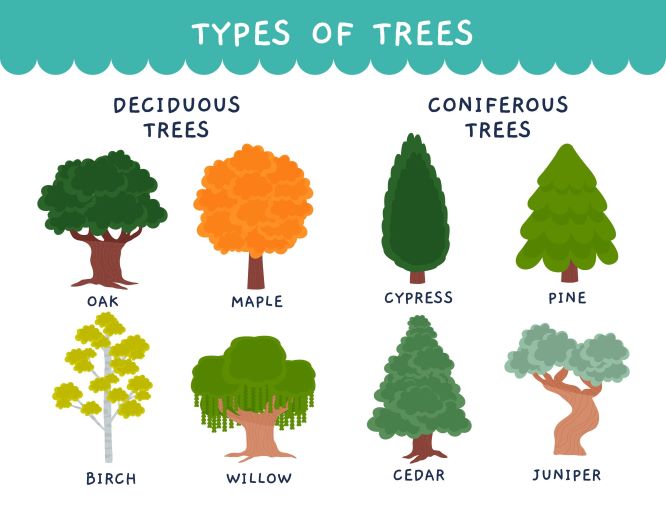Have you ever wondered which types of trees are best suited for your home? Whether you’re looking to create a cool, shaded backyard retreat, enhance your property’s privacy, or boost your home’s curb appeal, selecting the right trees can make all the difference. With so many options to choose from, it’s essential to understand the various types of trees and how they can meet your specific needs.
Trees do so much more than just beautify your landscape—they provide shade, reduce energy costs, improve air quality, and even increase property value. In this guide, we’ll explore the types of trees that are perfect for homes, focusing on shade, privacy, and landscaping. We’ll also discuss factors to consider when choosing the right tree and tips for planting and maintenance.
Let’s dive into the world of trees and discover how they can transform your home and outdoor spaces.
1. Why Choosing the Right Types of Trees Matters for Your Home
Planting trees around your home is not just about aesthetics; it’s about creating an environment that supports comfort, sustainability, and functionality.
Benefits of Planting Trees at Home
Trees offer a wide range of benefits, from improving air quality to providing much-needed shade during hot summer months. They help reduce the urban heat island effect, lower cooling costs, and create habitats for wildlife. Additionally, mature trees can increase property value by as much as 10-20%.
Different Purposes for Trees
Each type of tree serves a specific purpose:
- Shade trees provide relief from the sun.
- Privacy trees act as natural barriers and screens.
- Landscaping trees enhance the visual appeal of your property.
Choosing the right tree depends on your goals, local climate, and the overall design of your outdoor space. Selecting the wrong type of tree can lead to challenges like overcrowding, root interference, or maintenance headaches.
2. Best Types of Trees for Shade at Home : Creating Cool and Comfortable Outdoor Spaces
If your goal is to create a cool, shaded area for relaxation or outdoor activities, shade trees are an excellent choice. These trees typically have broad canopies and grow to significant heights, offering relief from the summer heat.
What to Look for in Shade Trees
When selecting shade trees, consider the following:
- Broad canopies to block sunlight effectively.
- Deciduous trees (those that lose their leaves in winter) to allow sunlight in colder months.
- Fast-growing species for quicker results.
Top Shade Tree Varieties
- Oak Trees
- Types: Red Oak, White Oak, Live Oak.
- Benefits: Long-lived, strong, and provide excellent shade coverage.
- Maple Trees
- Types: Sugar Maple, Red Maple.
- Benefits: Known for their dense canopies and vibrant fall colors.
- Sycamore Trees
- Benefits: Large, fast-growing trees with sprawling canopies.
- American Elm
- Benefits: A classic shade tree that can grow exceptionally tall.
According to the Arbor Day Foundation , shade trees can reduce energy costs by lowering summer cooling needs.
- Benefits: A classic shade tree that can grow exceptionally tall.
Planting and Placement Tips for Shade Trees
- Plant shade trees on the south or west side of your home to block the sun’s rays.
- Leave ample space to accommodate their mature size and root systems.
- Water regularly during the first few years to establish strong roots.
3. Types of Trees for Privacy Home : Creating Natural Screens and Barriers
If privacy is your priority, consider trees that grow densely and quickly. Privacy trees act as natural fences, reducing noise and shielding your outdoor spaces from prying eyes.
Characteristics of Privacy Trees
- Evergreen varieties for year-round coverage.
- Dense foliage to block views.
- Fast-growing species for quicker results.
Best Privacy Tree Varieties
- Leyland Cypress
- Benefits: Fast-growing evergreens that form dense barriers.
- Ideal for large properties or borders.
- Arborvitae
- Benefits: Narrow and tall, perfect for tight spaces.
- Bamboo
- Benefits: Rapid growth and a unique, tropical appearance.
- Note: Requires regular maintenance to prevent overgrowth.
- Holly Trees
- Benefits: Dense foliage and attractive red berries during winter.
Always check your USDA Plant Hardiness Zone Map before planting privacy trees to ensure they thrive in your region.
- Benefits: Dense foliage and attractive red berries during winter.
Tips for Planting Privacy Trees
- Space trees appropriately to allow for healthy growth.
- Layer different tree types for a natural and effective screen.
- Regular pruning ensures dense and uniform coverage.
4. Types of Trees for Landscaping: Enhancing Your Home’s Curb Appeal
Trees are an essential element in any landscaping design. They add texture, color, and seasonal interest to your outdoor spaces, creating a visually appealing environment.
Considerations for Landscaping Trees
- Size and shape: Ensure the tree fits the scale of your property.
- Seasonal interest: Choose trees that offer flowers, vibrant foliage, or fruit.
- Low maintenance: Opt for species that require minimal upkeep.
Popular Landscaping Tree Varieties
- Dogwood Trees
- Benefits: Beautiful spring blooms and striking fall foliage.
- Japanese Maple
- Benefits: Ornamental leaves and a unique structure.
- Crepe Myrtle
- Benefits: Long-lasting summer blooms in a range of colors.
- Redbud Trees
- Benefits: Early spring flowers that add a pop of color.
Layering Trees for Landscaping
Combine different types of trees to create depth and interest in your landscape. For example, pair tall shade trees with smaller ornamental trees for a more dynamic look.
Factors to Consider When Selecting Types of Trees for Your Home
Choosing the right tree requires careful planning and research. Here are some key factors to keep in mind:
- Climate Zone
- Use the USDA Plant Hardiness Zone Map to determine which types of trees will thrive in your area.
- Soil Type
- Test your soil for pH levels, drainage, and nutrient content.
- Available Space
- Consider the mature size of the tree, including height and spread.
- Maintenance Requirements
- Some trees require frequent pruning and care, while others are more low-maintenance.
- Environmental Impact
- Opt for native species whenever possible to support local ecosystems.
6. Tips for Planting and Caring for Your Trees
Proper planting and care are essential to ensure the health and longevity of your trees.
Planting Tips
- Timing: Plant trees in early spring or fall for the best results.
- Hole Size: Dig a hole twice as wide as the root ball but no deeper.
- Soil Preparation: Add organic matter to improve soil quality.
Caring for Your Trees
- Water newly planted trees regularly to establish roots.
- Mulch around the base to retain moisture and regulate soil temperature.
- Prune dead or diseased branches to promote healthy growth.
7. Common Mistakes to Avoid When Choosing and Caring for Trees
Avoid these common pitfalls to ensure your trees thrive:
- Planting the wrong species for your climate.
- Ignoring the mature size of the tree, leading to overcrowding.
- Neglecting maintenance like watering and pruning.
- Planting too close to buildings or underground utilities.
- Overplanting one species (lack of biodiversity can lead to pest issues).
Conclusion: Making the Right Choices for Your Home Landscape
Choosing the right types of trees for your home is a decision that can have a lasting impact on your environment and quality of life. Whether you’re looking for shade, privacy, or a boost to your landscaping, there’s a tree out there perfectly suited to your needs. By understanding the characteristics of different types of trees and taking the time to plan and care for them, you can create a beautiful and functional outdoor space.
Take the next step: research your options, consult with local experts or nurseries, and start planting the trees that will transform your home.
Key Takeaways
- Trees provide shade, privacy, and beauty to your home.
- Different types of trees serve different purposes: shade, privacy, or landscaping.
- Consider factors like climate, soil, and maintenance before planting.
- Proper planting and care are essential for long-term tree health.



